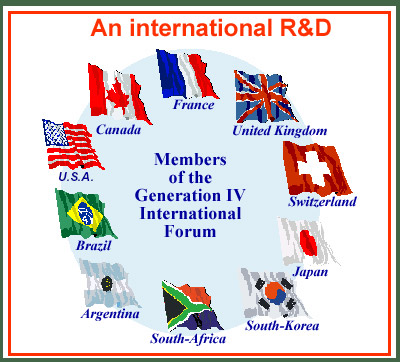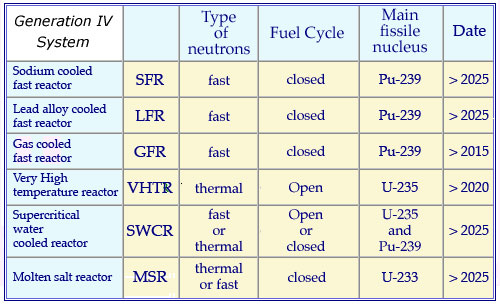Towards a fourth generation of reactors
To meet the formidable challenges of sustainable development – which are not all technological – it may become necessary one day to resort to new types of reactors, able to satisfy the growing global demand for energy.

The Generation IV International Forum (GIF)
In recent years, a Generation IV International Forum (GIF) has been set up in to guide the research undertaken on new reactors and to make best use of shared resources. Although the Forum initially had only ten members, it expanded in 2003 to include the countries of the European Commission. The most notable absentees include Germany (for internal political reasons) and India (owing to an as yet underdeveloped nuclear program).
© GIF
In 2001, ten countries agreed to cooperate on developing a new ‘generation’ of nuclear energy producing systems, collectively known as ‘Generation IV‘. Listed alphabetically, those countries were Argentina, Brazil, Canada, France, Japan, South Africa, Switzerland, the United Kingdom and the United States. The European Commission joined in 2003 and was followed by Russia and China in 2006.
This international agreement has been followed by working regular meetings, where results are discussed. A technology road map has been set out accordingly to the fashionable jargon now in use.
The objective of this research is to design nuclear ‘Generation IV’ reactors compatible with a sustainable development and acceptable to society. These specifications require calls for much more efficient fuels, improved safety, minimal production of radioactive waste and do not lend to the diversion of fissile material.

Principal characteristics of the six types of Generation IV reactors
Acronyms of the six types of Generation IV reactors, along with the type of neutrons used – fast or thermal (slow) – and of fuel cycle. In a closed cycle the fuel is reprocessed and reused which ensures a far greater efficiency. For simpler, open cycles, the fuel passes through a reactor only once. The dates shown indicate the dates by which the prototypes could be made.
© IN2P3
Within this initiative, six designs of reactors have been selected – four of which are ‘breeder’ reactors which can regenerate the fissile isotopes they burn. Some of these will even be able to burn plutonium and other actinides left behind, leading to the reduction of the stockpiles of these controversial materials. One of these four rbreeder reactors would use thorium instead of uranium 238, thereby producing very little plutonium and very few actinides. A version of this reactor powered by fast neutrons would also be able to burn up quantities of actinides produced by today water reactors.
Three of the four breeding reactors involve fast neutrons – cooled down by gas, lead, or liquid sodium. The fourth uses thorium-based fuel, and is remarkable in that the fuel is dissolved into the soluble cooling liquid. In this case there are no more the problems of the resistance to radiation of fuel rods. The materials may in principle remain indefinitely in the reactor core. All heavy nuclei of thorium, uranium, plutonium, … entering the reactor will come out « feet first » because they would be ultimately destroyed by fission, whatever the route taken.
Another potentially interesting area of research is that of high-temperature reactors – which are not ‘breeders‘ but have a much better thermal efficiency than conventional reactors. One of their interests is that they may have applications other than electricity generation, in particular the separation of hydrogen to replace oil in tomorrow cars or desalination of seawater or industrial chemistry.
A great deal more research and developments (R and D) are needed to have such reactors up and running by the year 2030. There are also a number of technological obstacles that need to be overcome. For instance, the Gas-cooled Fast Reactors (GFRs) and Very High-Temperature Reactors (VHTRs) are cooled by helium gas stored at very high pressures. This inert gas is not corrosive for structures, but these structures should resist to output temperatures which could be close or exceed 1000 ° .
A set of specifications and ambitious objectives
An ambitious set of specifications defines the objectives of Generation IV’s « Nuclear Generating Energy Systems » (By « Nuclear Generating Energy System », one means not only the reactors but what goes with them such as fuel fabrication, reprocessing , storage facilities).
The objective is to achieve reactors compatible with a sustainable nuclear power that should acceptable to society. The specifications require that they be fuel-efficient, particularly safe, produce a minimum of waste and be unsuitable for the diversion of fissile material for military purposes.
Other articles on the subject « Future Reactors »
Generation III Reactors
The reactors of tomorrow before those of after tomorrow Designed in the 1990s, third-generation r[...]
EPR Reactors
EPR: a third generation pressurized water reactor Third generation reactors are reactors intended[...]
The nuclear option ?
Energy challenge : meeting energy demands of the Future The emergence of huge future needs by de[...]
Molten Salt Reactors
Promising reactors … but in a remote future Molten Salt Reactors are very different in desi[...]